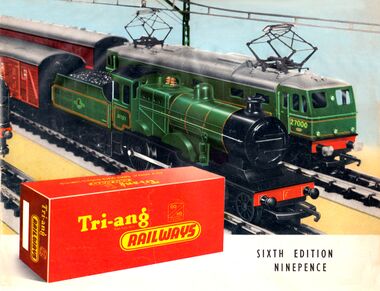Category:Tri-ang Railways Overhead Power Supply System
Front cover of the 1960 Tri-ang Railways catalogue [image info]
Tri-ang launched their Tri-ang Railways Overhead Power Supply System for model railways in their 1959 catalogue.
Although this system wasn't for everyone (obviously, it wasn't suitable or appropriate for powering locomotives that didn't have "pantograph" electrical pickups in their roofs), if one wanted to run a model of a modern electric "caterary and pantograph" system, Triang were the only major manufacturer to offer a solution in the UK (the "caternary" is the overhead contact wire, the "pantograph" is the sprung electrical contact on the top of the locomotive that picks up the current).
Tri-ang's pantograph-equipped locomotives had a switch on the underside that let one use them either from overhead power, or more conventionally as two-rail electric model locomotives, which meant that they were still usable if a layout's overhead power system was experiencing difficulties.
Pantograph power: Tri-ang Railways vs Hornby Dublo
Triang produced a small but significant range of locos with working pantographs, and continued supporting the system into the Tri-ang Hornby era. The Hornby Dublo range responded with a single (rather nice) pantograph-equipped locomotive in 1963 (AL1 Class 81 locomotive E3002 (Hornby Dublo 2245)) ... but this was shortly before Meccano Ltd. went bust, and Meccano Ltd. never did get around to producing their own overhead power system for the locomotive before they were taken over by Tri-ang.
1959 promotional text:
Tri-ang Railways Overhead Power Supply System is here.
Tri-ang Railways keep pace with the modernisation of railways throughout the world and open a new model railway era.
Old limitations are left behind and twice the operational action will be possible on many Tri-ang Railways layouts. For the first time in Britain the builders of an established model railway system are producing overhead catenary equipment. Now to the thrills of traditional steam locomotives are added the new and intriguing outlines of modern electric locomotives hauling main line passenger trains and handling local goods traffic.
The first Tri-ang Railways locomotives fitted with realistic operating pantographs for use with the Overhead Power Supply System are a powerful type for main line use and a smaller model for general duties.
— Introduction, Tri-ang Railways catalogue, Fifth Edition, 1959
1960 promotional text:
Tri-ang Railways Overhead Power Supply System makes it possible (with certain limitations) to operate two trains simultaneously and under independent control on the same section of track, one locomotive collecting its power from the track and the other from the Overhead Power Supply System.
The locomotives fitted with operating pantographs collect their 12/15 volts D.C. (Direct Current) from the catenaries suspended above either Standard or Series 3 Track. These catenaries are supported by masts fitted into mast bases or clips. The bases are either located in the track or fixed against the track on a baseboard. Clips are provided to fit the masts to track sidewalls so that high level operation can be undertaken with the Overhead Power Supply System.
Catenaries may be run under Girder Bridges or a section of high level track. Foundations are available to raise High Level Piers and Girder Bridge Supports sufficiently to clear the catenaries.
In all Overhead Power Supply System locomotives there is a three-position switch. With the switch in position "OH" and the pantograph raised the locomotive can be operated from the overhead supply. With the switch set to position "TK" the current is collected from the track, through the wheels of the locomotive, in the orthodox fashion. When the switch is in the neutral position "N" the locomotive is isolated from both the overhead and track power supplies.
— Overhead Power Supply System, Tri-ang Railways catalogue, Sixth Edition, 1960
External links
Media in category ‘Tri-ang Railways Overhead Power Supply System’
This category contains only the following file.
- Triang Railways, 1960 catalogue front cover, sixth edition (TRCat 1960).jpg 2,200 × 1,685; 935 KB




